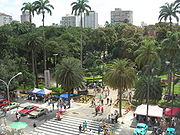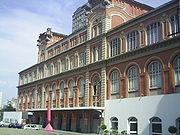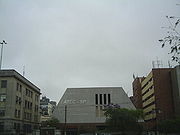
Bom Retiro, São Paulo
Encyclopedia





São Paulo
São Paulo is the largest city in Brazil, the largest city in the southern hemisphere and South America, and the world's seventh largest city by population. The metropolis is anchor to the São Paulo metropolitan area, ranked as the second-most populous metropolitan area in the Americas and among...
, Brazil
Brazil
Brazil , officially the Federative Republic of Brazil , is the largest country in South America. It is the world's fifth largest country, both by geographical area and by population with over 192 million people...
. It is a mainly commercial place, as the industrial and residential areas are greatly decreasing.
The district is served by Line 1 (Blue)
Line 1 (São Paulo Metro)
Line 1 - Blue was the first line built for the São Paulo Metro. It links Tucuruvi Station to Jabaquara Station. Construction began in the late 1960s and was completed in the early 1970s. It was also the first metro line built in Brazil.-History:...
of the São Paulo Metro
São Paulo Metro
The São Paulo Metro is the principal rapid-transit system in the city of São Paulo and the largest in Brazil. It is also the second largest system in South America and the third largest in Latin America, behind Mexico City and Santiago....
and by the lines 7 (Ruby)
Line 7 (CPTM)
Line 7 is a line of the Companhia Paulista de Trens Metropolitanos commuter rail system in São Paulo, Brazil. -External links:...
, 10 (Turquoise)
Line 10 (CPTM)
Line 10 is a line of the Companhia Paulista de Trens Metropolitanos commuter rail system in São Paulo, Brazil. -External links:...
, and 11 (Coral)
Line 11 (CPTM)
Line 11 is a line of the Companhia Paulista de Trens Metropolitanos commuter rail system in São Paulo, Brazil. -External links:...
of the CPTM. There is also a planned station for Line 4 (Yellow)
Line 4 (São Paulo Metro)
Line 4 is a line of the São Paulo Metro, originally called Southeast-Southwest Line. When finalized, it will go from Luz to Vila Sônia. The first stretch, between and Faria Lima and Paulista stations, opened on May 25, 2010. Two other stations, Butantã and Pinheiros, took more time than expected...
of the São Paulo Metro
São Paulo Metro
The São Paulo Metro is the principal rapid-transit system in the city of São Paulo and the largest in Brazil. It is also the second largest system in South America and the third largest in Latin America, behind Mexico City and Santiago....
.
Formation
In the late 19th century and in the early 20th century, Bom Retiro was considered a modern region, when the Luzand the Júlio Prestes Rail Road Stations, along with Jardim da Luz
Jardim da Luz
Jardim da Luz is a public space, characterized as a public park or as a small park, with approximately 20 thousand square meters situated in Avenida Tiradentes, Bom Retiro, in the city of São Paulo. The park is near the Luz station, the Museu de Arte Sacra de São Paulo, and the Historic Department...
, then São Paulo's only public park, were elegant examples of European-influenced—Luz Station was actually built in England and assembled in Brazil—architecture and landscaping.
It was an industrial section. In the 1960s, factories began being replaced by active clothing and fashion retail stores and textile and weaving small businesses. The neighborhood had an influx of Mediterranean immigrants such as Italians, European Jews, Syrians, Lebanese, and a few Greeks. The area across from Tiradentes Avenue was mostly populated by Armenians. In greater numbers, the Italians settled in the sections of Bela Vista, Brás, Ipiranga, and Barra Funda and other parts of the state. The Jewish presence was especially felt on the Rua Prates region, with the Renascenca school and college, synagogues, Kosher stores and restaurants, some of which are still active. After acquiring prosperity from their retail businesses, the Jews migrated to the newer and more affluent sections of Higienopolis, Cerqueira Cesar and Jardins. The Syrian-Lebanese dominated the Rua José Paulino shopping centers as well as the more affluent Paraíso and Vila Mariana sections near the starting point of the Avenida Paulista new financial center.
Bom Retiro was the entry gate of the immigrant arrivals from the port of Santos, who landed in the city by train via Luz station, or continued their journey towards the coffee plantations in the state interior via the Santos-Jundiai line or shifted to the São Paulo Railway line, later E.F. Sorocabana at Julio Prestes station towards São Paulo State's SW, NW, and Parana' State. Julio Prestes now operates only local trains in the Greater São Paulo region and had some of its halls transformed into the State of the Art Sala Cidade de São Paulo Concert Hall, home to the São Paulo Symphonic Orchestra. Luz Sta. has trains to the Eastern suburb cities of the Greater São Paulo region, such as Santo André, Mogi das Cruzes, Suzano and Poá. In addition, the Jundiaí line still serves that city and the São Paulo's Westside sections suburbs, such as Barra Funda, Lapa, Piqueri, Pirituba, Caieiras, Franco da Rocha, and Francisco Morato. A section of Luz station has been transformed into the interactive Museu da Lingua Portuguesa, the world's only Lusophone—Portuguese language related—museum dedicated in the mid 2000s with the presence of Portuguese, Brazilian, African and Asian authorities of those countries once ruled by the Portuguese crown. It is an important stop for those who study the language and the field of Linguistics, as well as anthropology, uses of language, folklore, language development and foreign influences, dialects, poetry, music, origin of names of foods and utensils and other curiosities. The Pinacoteca do Estado de São Paulo
Pinacoteca do Estado de São Paulo
The Pinacoteca do Estado de São Paulo is one of the most important art museums in Brazil. It is housed in a 1900 building in Jardim da Luz, Downtown São Paulo, projected by Ramos de Azevedo and Domiziano Rossi to be the headquarters of the Lyceum of Arts and Crafts...
, the Museu de Arte Sacra de São Paulo -- Sacred Art Museum, with an impressive Brazilian Baroc Art collection and a giant Nativity Scene from Naples, the Pinacoteca Station Art Institute, and the Centre for Music Studies - Tom Jobim are also in the area. The old building of the Polytechnic School of the University of São Paulo
Polytechnic School of the University of São Paulo
The Polytechnic School of the University of São Paulo is an engineering school in the University of São Paulo in São Paulo, Brazil...
now holds the State of São Paulo Technical College and the São Paulo Federal Technical School.
Jardim da Luz is considered the oldest park and one of the few green areas in the central region of São Paulo. Despite its sculptures and grottoes installed and maintained by the Pinacoteca museum next door, it has an intense movement of prostitutes, a few country music singers, as well as itinerant preachers and peddlers. Across from the park through the Luz station in the Old Centro direction, drug activity is not uncommon, which gave the region a bad reputation as the "Cracolandia," or "Crackheadland." Despite the City's attempt to revamp the dilapidated area by demolishing and remodeling buildings and giving incentives to big businesses to settle and build apartment and office buildings there, it is unsafe to stroll along the area, particularly at night, because of rampant crime and other illegal activities. There are entire old buildings invaded by "Sem-Terra" or "Sem-Teto" homeless individuals. With the São Paulo Old Centro Renaissance efforts, a few "noias," or homeless adults and glue-sniffing children have moved toward the Republica and Sé Squares regions. It is wise to visit the attractions of Bom Retiro section within a group of people and during daytime or inquire about bus guided tours. The Luz metro and train stations are well served with police and, after a robbery of important works of art at the Pinacoteca Institute, as well as at the MASP São Paulo Art Museum at avenida Paulista, greater surveillance is being done in the museums.
Most people live in "cortiços" or tenements in Bom Retiro. The Rua José Paulino clothing retail shops and sweatshops, together with the Rua 25 de Março bargain clothing stores near Parque Dom Pedro/Bras have been managed by Koreans who employ other Koreans and Latin Americans such as Bolivians. Bom Retiro has now become the second largest Asian stronghold in the city, after the traditional Liberdade Japanese section. Koreans are now known to control two thirds of the clothing retail business and their materials travel all over Brazil. Retailers and lovers of budget and yet fashionable articles fly across the country and from African countries as far as Angola and Cape Verde just to shop in this international bargain shopping center.
On 6 January 2010, the São Paulo City Council officially recognised Bom Retiro as being the Korean cultural neighbourhood.
Borders
- North: Tietê RiverTietê RiverThe Tietê River is a Brazilian river in the state of São Paulo.The source is in Salesópolis in the Serra do Mar, at 1,120 m altitude...
; - South: Mauá Street/Railway of CPTM (Lines A, D, and E);
- East: Cruzeiro do Sul Avenue and Estado Avenue;
- West: Railway of CPTM (Line B), Engenheiro Orlando Murgel Viaduct, Rudge Avenue, and Casa Verde Bridge (beginning).
- Item de lista com marcadores
Neighboring Districts
- Santana (North);
- Pari (East);
- Brás (Southeast);
- Sé and República (South);
- Santa Cecília and Barra Funda (West).
Principal Attractions
- Pinacoteca do Estado de São PauloPinacoteca do Estado de São PauloThe Pinacoteca do Estado de São Paulo is one of the most important art museums in Brazil. It is housed in a 1900 building in Jardim da Luz, Downtown São Paulo, projected by Ramos de Azevedo and Domiziano Rossi to be the headquarters of the Lyceum of Arts and Crafts...
; - Luz StationLuz StationThe Luz Station is the common name for a train station in the Luz neighbourhood in São Paulo, Brazil. The station is part of the metropolitan rail system ran by the CPTM. The station is mostly notable for housing the Museum of the Portuguese Language, established in 2006...
(CPTM); - Museum of the Portuguese LanguageMuseum of the Portuguese LanguageThe Museum of the Portuguese Language is an interactive Portuguese language — and Linguistics/Language Development in general — museum in São Paulo, Brazil. It is housed in the Estação da Luz train station, in the urban district of the same name...
; - Júlio Prestes Station;
- Sala São PauloSala São PauloThe Julio Prestes Cultural Center, which is located in the Julio Prestes Train Station in the old north central section of the city of São Paulo, Brazil, was inaugurated on July 9, 1999. The building has been totally restored and renovated by the São Paulo State Government, as part of the downtown...
; - Pinacoteca Station;
- Museu de Arte Sacra;
- Igreja de Santo Antônio de Sant'Ana Galvão.
Curiosities
- The Hospedaria dos Imigrantes ("Immigrants' Inn") was situated in Bom Retiro. It remained there until the 1880s, when it moved to Brás.
- Bom Retiro was once a neighborhood where the Italian and Jewish communities predominated. Nowadays, the Korean, Chinese, and Bolivian presence is very strong.
- Sport Club Corinthians PaulistaSport Club Corinthians PaulistaSport Club Corinthians Paulista, commonly just known as Corinthians , is a Brazilian football club based in the city of São Paulo. They play in the São Paulo state league, as well as the Brasileirão, Brazil's top national league...
, one of the main soccer teams in São Paulo, was founded by residents of Bom Retiro, in the year of 1910, in Rua José Paulino.
See also
O Ano em Que Meus Pais Saíram de FériasO Ano em que Meus Pais Saíram de Férias
The Year My Parents Went on Vacation is a 2006 Brazilian drama film directed by Cao Hamburger. The screenplay, which took four years to be completed, was written by Hamburger, Adriana Falcão, Claudio Galperin, Anna Muylaert and Bráulio Mantovani....
is a film that takes place in 1970 in Bom Retiro. The film is about the 1970 FIFA World Cup
1970 FIFA World Cup
The 1970 FIFA World Cup, the ninth staging of the World Cup, was held in Mexico, from 31 May to 21 June. The 1970 tournament was the first World Cup hosted in North America, and the first held outside South America and Europe. In a match-up of two-time World Cup champions, the final was won by...
and the military dictatorship that took place after the 1964 Brazilian coup d'état. It also shows how strong the central European Jewish and Italian immigrant concentration was (a soccer match between the Italians and the Jews was held in Bom Retiro).

